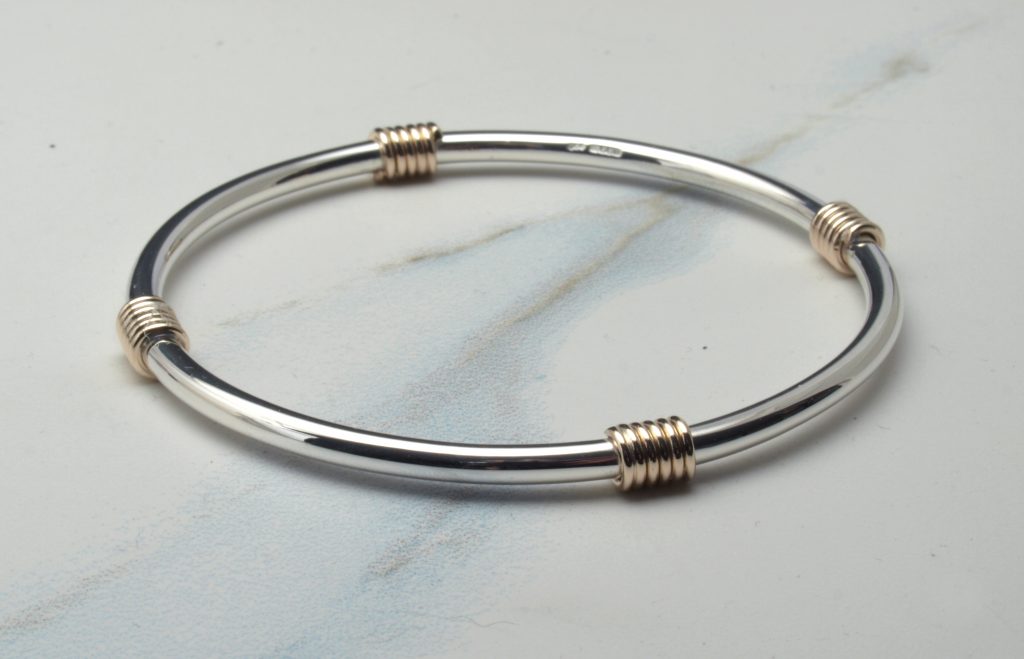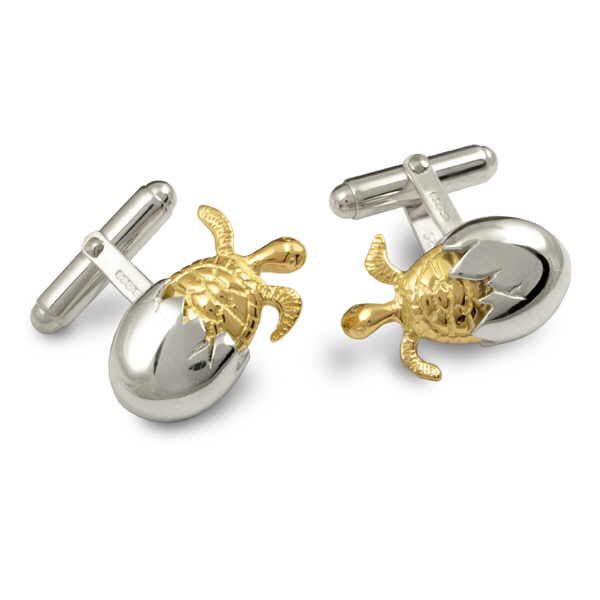Precious Metals

There are various metals that you can choose for your jewellery and they all have their own advantages, disadvantages and cost implications. This page gives you a quick rundown of the various options so that you can make an informed decision if you are looking to commission a piece of jewellery.
Gold
Amazing shiny stuff, gold. Caused a lot of problems down through the ages due to its rarity and also the fact that it stays shiny whatever you do to it. Pure gold is almost completely non-reactive which means that, unlike other metals it won’t dull down or corrode through contact with oxygen and other aggressive chemicals.
This would make it ideal for use in jewellery if it wasn’t for the fact that it is so dense and soft. This means that it has to be mixed or ‘alloyed’ with other metals to give it strength and toughness.
This affects the colour of the metal, which can be problematic, but it also reduces the cost somewhat depending on how much gold is actually present in the resulting metal. In the UK the minimum standard for gold is 9ct or 375. This means that it is 375 parts per thousand gold and the rest is made up of other metals. You will realize then that 9ct is not, strictly speaking, gold.
The table below gives you the other standards and so you can choose just how much gold you want your jewellery to be made out of.

As you go to the higher standards the metal becomes yellower, denser and softer. This means that a piece of 18ct gold will weigh much more (1.6 times) than a piece of 9ct of the same dimensions (and so will be much more than twice as expensive).
In America 14ct is the minimum standard and this does, at least have the virtue of being more than 50% actual gold. In most European countries 18ct is the standard and they consider the 9ct that we use in the UK to be a pale and insipid imposter.
You should consider the colour as well as the intrinsic value of the metal when choosing materials for your jewellery but please also be aware that, the higher the carat, the softer the gold will be and this may have a influence on what is practical for the design. 18ct gold rings often need to have claws replaced after a number of years of continuous wear and even the shanks wear out if they rub against another ring on the same finger.
White, rose and green gold (yes, green)
The colour of gold can be altered depending on which metals are added to it in the alloying process. Oddly, a metal that is still 750 parts per thousand gold can be turned white by adding other metals. Get your children (or nieces) mixing poster paints and see if they can achieve the same result)
However, you should be aware that white golds are not white. (Yes it’s a scandal) 9ct white gold is a very pale yellow and 18ct white is more of a grey.
To get around this, much white gold on the market is plated with rhodium to give it a hard white shine. By the time this has worn off you don’t look at the ring in the same way any more and will probably not notice the change in colour. I would generally choose not to use rhodium where it will wear off (although I will if this is what you want) so you need to choose your white golds with care and an eye to the long term. If you want to combine yellow and white then 18ct golds give the best contrast and you should consider platinum or palladium if you want a better white metal.
You can also consider red or ‘rose gold’, very popular with the Victorians, and even green gold. To be fair, green gold is not that green but if you put it next to yellow gold then you can see a difference.


Platinum
Platinum is really expensive and really dense. It’s approximately twice as dense as 9ct gold and about 3 times more expensive. Therefore a ring that would cost £100 in 9ct gold is going to cost nearer £600 in platinum.
It is harder and whiter than white gold and so you are getting something extra for your money but you need to be aware that working in platinum is a whole other thing financially and you might want to spend the money on a bigger or better stone…or something else entirely. These days, largely due to the extraordinary rises in precious metal prices, I’m tending to suggest that my clients consider palladium as a good alternative to platinum.
Palladium
Palladium is one of the platinum group of metals and comes just above it it the Periodic Table. It’s very similar visually but is much less dense and much less expensive. It’s been used in jewellery for centuries and was popular in Victorian times, and it’s experiencing something of a renaissance at the moment. It went something like this: There has been a trend, recently for diamonds set in white metals and so 18ct gold and platinum became popular choices for engagement and eternity rings. Then, having been stable for decades, the price of those metals went bananas in the last few years, and soared out of some people’s price range. The platinum ring that was £600 was suddenly £1,300 and so palladium became a much more attractive option.
At the time of writing, palladium is about half the price of platinum and, being about half as dense, works out to be much cheaper by volume. Other than the fact that it feels lighter, you’ll not tell it apart from platinum and, as of 2009, when the Assay Offices introduced a new palladium hallmark, it’s a bona fide precious metal once again.
Silver
Silver has always been much more common than gold and so is a fraction of the price. It’s considered a semi-precious rather than a precious metal but you shouldn’t dismiss it as a material for a special piece of jewellery. Because it is softer than the precious metals it’s not really suitable for claw set engagement rings that will need to withstand a life-time’s wear, but for wedding bands and more substantial pieces it’s a good low-cost alternative. The standards for silver are 925 (parts per thousand), known as ‘Sterling silver’ and 958 or ‘Britannia silver’. Generally it’s 925 that’s used in jewellery as it’s a bit harder and tougher than 958 and so will hold it’s shape and resist wear rather better.
Skin reactions to silver
About two times a year I have someone contact me in the belief that I’ve sold them something other than silver because their skin had gone black….or green (usually just the finger, not the whole of it). Other metals such as copper and brass will do this but, once in a while, sterling silver has the same effect. It’s usually to do with the specific metals that the silver has been alloyed with reacting with that persons specific skin chemistry and it’s usually a ring that causes the problem, where perspiration builds up between the ring and the finger.
silver grain
Because there are 75 parts per thousand to play with in 925 silver, different bullion manufacturers use different metals to provide various qualities for the resultant metal. Mostly it’s copper but, especially when metal is being cast and it needs to flow and cool at the appropriate rate, there are traces of other metals in there as well.
It’s generally one of these other metals that is causing the problem. This is why some people find that one 925 silver ring is fine but another one gives them a problem. When this arises I generally try to remake the piece from a different metal so, if the original piece was cast, then I’ll fabricate a new one from sheet and wire which are processed in a different way. If this doesn’t work then we can rhodium plate the piece where it touches the skin. This will eventually need to be repeated but it generally solves the problem for a number of years. Recently, though, a new alloy has become available and this offers an excellent alternative solution.
Argentium silver
Argentium is the brain-child of Peter Jones, a metallurgist working at Middlesex University. He discovered that the addition of germanium imparted many beneficial properties to silver alloys. Many years have gone into the development of this new alloy and it is now being made available to the jewellery manufacturing community and an excellent alternative to Standard or ‘Sterling’ silver.
The main benefits for the wearer are the increased hardness and whiteness and also its anti-tarnish and hypo allergenic properties. This makes it the perfect solution for the perineal ‘black-finger problem’ outlined above but also means that silver jewellery will now stay bright without needing to be polished repeatedly.
Argentium alloys are produced in 935 or 960 parts per thousand, making them purer than Standard 925 silver. This, coupled with the extra costs involved in producing the alloys, makes them more expensive but the advantages more than outweigh the small extra cost.
If you are interested in having a piece in my range made for you in Argentium rather than Standard silver then please contact me to arrange this.

